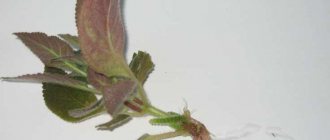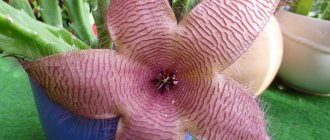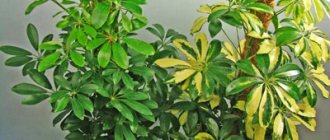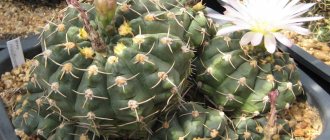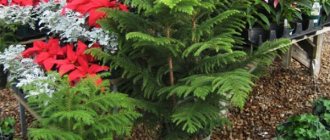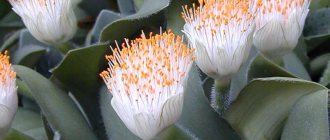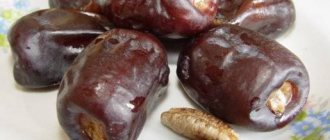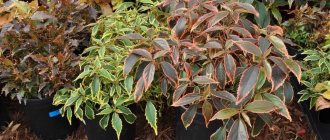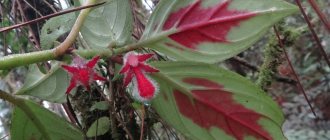Hypocyrta is an exotic indoor plant that has become famous recently. In America and Great Britain it is called “goldfish”. It is translated from Greek as “thickened at the bottom.”
Grown as an ampelous and bush flower. According to popular superstitions, nemanthus, the second name, has miraculous properties, brings happiness, prosperity, and cleanses the house. When the plant looks healthy and well-groomed, the owners' mood rises.
Botanical description
Nematanthus is a tropical plant. Latin America is considered to be its homeland.
The flower is a small shrub with small, waxy, dense leaves located on curly elastic shoots. It blooms in summer with medium-sized bright single flowers, thanks to which it received another name - “kiss of summer”.
| Root system | Branched, superficial, thin roots |
| Stem | Dense, fleshy, creeping |
| Leaf color | Dark green, waxy, glossy |
| Flower shape | Tubular, expanding at the bottom |
| Flower color | Depending on the variety, the shade varies from yellow to red. |
| Fruit shape | Seed pod |
White (Albus/Santa Teresa)
Namatanthus White is a plant with large tubular cream-colored flowers , which are crowned with long branching shoots (up to 70 cm in length). The leaves are large, dark green, reddish below. In the photo you can see what the plant looks like.
It differs from other species in its aroma, which attracts tropical bees.
Main types
Hypocyrta comes in many different species.
Some of them are ideal for growing at home:
- Hypocyrta Monetnaya - This is an unusual species with creeping stems. A distinctive feature of this variety is the fluff covering the rounded leaves of the plant. The length of the shoots does not exceed 15 cm, the flowers are glossy, orange-red. For the winter, this variety sheds its leaves;
- Glabra - is a small shrub with erect, dense stems covered with glossy small elongated leaves - dark green on top and lighter below. The height of the shoots is approximately 50–60 cm, at the base of the leaves there are orange buds in groups of 2–3 pieces;
- Tropicana - a magnificent view with diamond-shaped glossy leaves of a dark green color. The stems are tall and straight. The variety blooms profusely and continues throughout the summer. The flowers are yellow, with dark orange stripes along the bud;
- Gregarius - is a hanging plant with low-creeping stems. The leaves are small, shiny, densely located on the shoot; have an elongated, slightly pointed shape. The culture blooms with small tubular flowers (depending on the variety - red or yellow);
- Nematanthus Columnea - the most striking representative of this species. The stems are semi-erect, approximately 30–40 cm long, the foliage is large, green, pointed, with deep veins. The flowers are large, tubular, scarlet in color. This variety is separated into a separate genus due to a number of external differences from the classic representatives of Nematanthus;
- Variegated - got its name due to the unusual color of the foliage: small, waxy leaves in the center are dark green, and have a light green edge along the edges. Sometimes there is another option - light leaves with dark “scorches” along the edges. The flowers are standard orange.
Not all epiphytes are parasites
Hypocyrta does not exactly belong to plants that parasitize others. She uses them only as a support in the dark Latin American rainforests, in order to rise above the ground and not be eaten or trampled by herbivores. And be closer to the sun's rays for better photosynthesis.
In terms of its adaptability to fastening on something, our flower can be compared with the well-known and abundantly flowering woody plant Campsis with flowers of unique beauty. It finds not only neighboring trees, but even the wall of a house in the form of physical support, clinging to bricks or plaster and even slate in order to rise two or three floors.
Therefore, hypocyrta is beautiful both on the ground and in canopy culture. Out of genetic habit, it envelops even a hanging pot so that it hides in foliage that shines in any light.
The hypocyrtus flower emerges from the axils of the leaves and is collected in groups of up to three pieces, and not on the tops of the stems, as in many flowers. Owners compare it to human lips when kissing. From summer to mid-autumn, hypocyrta provides floral beauty.
Conditions for growing at home
Hypocyrta is a very popular plant for home cultivation. All the varieties described above take root safely in conditions that are comfortable for them.
At home, decorative foliage plants such as zebrin flower, cordyline, aphelandra, diplandia, and monstera are also grown.
Lighting
This flower crop is a light-loving plant (with sufficient lighting it is guaranteed to bloom for a long time). But the plant does not tolerate direct sunlight well, and in the summer heat this can lead to leaf burns. Intense but diffused light is recommended for the flower; In winter, you can use a source of artificial lighting.
Temperature
Despite the fact that hypocyrta is native to countries with hot climates, heat is contraindicated for this home plant. The ideal microclimate for the “kiss of summer” involves maintaining an optimal air temperature of +22...+24°C in summer and +14...+16°C in winter.
Important! Nematanthus is especially sensitive to drafts and sudden changes in temperature.
Air humidity
A tropical flower feels very comfortable in conditions of high humidity (if it is above 80%). That is why it is recommended to spray it frequently, and also place containers of water around the pot with the plant.
Features of growing in open ground
Hypocyrta is a tropical plant and when growing it in open ground, one should take into account the conditions of its growth in its natural environment.
The flower has an extremely negative attitude towards prolonged temperature changes . And the low temperature, which is typical even for warm regions of Russia in winter, is destructive for an exotic guest. In addition, hypocyrta does not like frequent transplants, which could help move it to a warm place for the winter. Therefore, it will not be possible to grow this flower outdoors in most cities.
Home care
Nematanthus is not too demanding to care for, but the basic rules must be followed.
Watering
Hypocyrta should be watered abundantly and regularly in the summer. Lack of moisture is detrimental to the flower; The water should be at room temperature or slightly warmer.
In autumn and winter, the frequency of watering is reduced. During this period, water the plant as the top layer of soil dries. Because the root of the plant is delicate and sensitive; To avoid damage to it, watering is carried out exclusively at the root, from a small height, drip (using a watering can, for example), and not with an intense stream.
Top dressing
It is necessary to fertilize the flower. Use ready-made industrial mineral fertilizers for flowering indoor plants “Promix” or “Fertika”. Complex mixtures with nitrogen and potassium fertilizers, which provide support during the growing season, would also be a suitable option. Fertilizing is carried out from April to September at least once every 7–10 days, when growth and flowering are intense. Fertilizer is applied at the root, combining with the next watering.
Read more about what and how to feed indoor plants.
Trimming
To ensure good branching and flowering in the next season, nematanthus shoots are pruned before the onset of winter cold - during the period when the plant slows down its life processes. Typically, each stem is cut to about 1/3 of its length.
Transfer
Good news for flower growers may be the fact that hypocyrta does not require traditional annual replanting. Its root system is quite thin and develops with moderate intensity, so transferring it to a new pot can be done once every 2 years. The pot for the flower is chosen to be small, in proportion to the branching of the roots (it is desirable that it be short and wide).
The soil should be light and porous. From ready-made substrates, a soil mixture for homemade violets is suitable, and when preparing the mixture yourself, it is enough to mix peat, sand, humus and leaf soil in equal proportions.
The plant is replanted in the spring before the flowering period begins: from early March to early April. You need to transfer the flower into new soil together with the earthen lump surrounding the roots to prevent them from being damaged. A layer of substrate is poured onto the bottom of the new pot, a small depression is made in it, into which the root is placed; then add the required amount of soil mixture so that it fills the voids of the container.
Important! It is imperative to create voids and a drainage layer in the container with the plant, otherwise root rot may develop.
After transplanting, the flower is watered with warm water, and after a few days, ready-made nitrogen-potassium fertilizers for indoor plants can be applied to the root.
Seasonal care
Hypocyrta actively develops in the spring and summer. For normal growth, it needs warmth, good lighting, regular feeding, and high humidity. Since autumn, the plant has been in a state of sluggish growth. He needs to be provided with proper care to give him the opportunity to rest before the next growing season. It is preferable to keep the culture in a cool room (+12..15°C). In such conditions, watering is reduced and fertilizing is stopped. Air humidity should be at 50-60%. Lighting should be sufficient throughout the year. Therefore, in winter, the plant needs to turn on additional lighting to extend daylight hours to 12-14 hours.
Propagation by cuttings
Hypocyrta successfully reproduces by cuttings. You can separate cuttings for propagation during a period of intensive plant growth, when the length of the shoot is sufficient (at least 6–7 nodes with buds). The cut shoot is placed in a container with wet sand, deepening to the lower leaves.
Caring for a seedling does not differ in technology from caring for an adult plant (with the only exception that it is recommended to cover it with a cap). From time to time, the sprout needs to be ventilated and hardened in room conditions. The air temperature should be within +22…+24°C.
As soon as the cutting gives its first long roots, it can be transplanted to a permanent habitat. It is allowed to plant one or several shoots in one pot.
We recommend reading how to properly plant indoor flowers in a pot.
How to prepare for wintering and care for a flower in winter?
In October, immediately after flowering has ended, the old branches are pruned, in their place in the spring new shoots will grow, in the axils of the leaves of which beautiful flowers similar to goldfish will appear.
In order for the plant to please you with its flowering next year, it needs to rest in winter. To do this, hypocyrta is kept in a bright and cool room.
During the rest period, it is important to follow the rules:
- keep the plant cool, at temperatures up to 12°C;
- provide very moderate watering;
- Maintain daylight for at least 12 hours; artificial lighting can be provided;
- when kept at a warmer temperature, maintain air humidity by spraying;
- the lower the temperature, the lower the humidity.
The minimum permissible temperature is 12°C; when this mark is reached, watering should be stopped.
Possible difficulties during cultivation
Despite the ease of care, novice gardeners may encounter some problems when breeding hypocyrta:
- if you water a plant with too cold water , its immunity will begin to weaken; This may cause dark or reddish spots to appear on the leaves. A similar phenomenon is observed when there is no watering for a long time. To avoid this problem, water the flower with settled soft water at room temperature, and in winter - slightly warm;
- lack of flowering is one of the main problems. There can be many reasons, but most often it is a lack of light, lack of feeding and sudden changes in room temperature. If such a difficulty arises, you should act in stages: first of all, you need to eliminate drafts. If the plant still does not bloom, it is necessary to move it to a more illuminated place away from direct sunlight;
- the plant loses foliage when there is excess moisture , fluid retention in the root area, and also when kept in a cold room. If you notice the loss of foliage, you should limit watering, move the flower to a warm place and wait until the earthen ball dries out. After the measures have been taken, watering is organized in such a way that the liquid does not linger at the bottom of the pot (drainage is used). In some cases, when signs of rotting appear, the plant is replanted, removing rotten roots during replanting;
- Violation of the humidity level and excessive watering can cause the appearance of powdery mildew or gray rot. If signs of these diseases are detected, you need to treat the leaves and stems with an industrially produced fungicidal solution - for indoor plants. The most commonly used preparations are Bona Forte or Discor (or a pale pink solution of potassium permanganate). The affected shoots are removed and the plant is moved away from healthy flowers.
To prevent the occurrence of the described problems, it is enough to strictly adhere to the rules of caring for the flower and prevent it from hypothermia.
Hypocyrta care mistakes, diseases and pests
If the standards for caring for hypocyrta are not followed, problems, diseases, and pests arise.
| Manifestations | Causes | Corrective measures |
| The leaves curl and turn yellow. | The sun is too bright. | Rearrange the flower or shade it. |
| Doesn't bloom. |
| Select the appropriate container and adhere to all care rules. |
| Leaves and buds fall off. |
|
|
| Brown spots on the plant. | Burns due to spraying. | Do not spray the leaves with water or leave them in direct sunlight. |
| Hypocyrta is fading. | The plant was overfed. | Do not violate the dosage, feed once every ten days. |
| Depressions in leaves. | The watering schedule has been disrupted. | Avoid overdrying or waterlogging the soil. |
| The plant withers, the leaves turn yellow. | Root rot. | Remove the flower from the pot, remove the affected roots, dry and replant, water with Carbendazim (Carboxin) |
| Fluffy mold on a flower. | Gray rot. | Remove diseased parts and change soil. Treat with Fundazol. |
| White coating on the plant. | Powdery mildew. | Trim the affected areas and treat with Fitosporin. Ventilate the room for prevention. |
| Light yellow spots, sometimes cobwebs are visible. | Spider mite. | Treat with Actellik, Fitoverm. |
| The shoots curl and insects are visible on the plant. | Aphid. | Spray with special anti-aphid products - Inta-vir, Decis. |
| Hypocyrta does not grow, flowers are deformed, leaves have silvery streaks. | Thrips. | Treat with Akarin, Actellik. |
| White, cotton-like coating on the shoots. | Mealybug. | Spray with Commander, Vermitek. |
Folk signs and superstitions
Like most indoor plants, nematanthus acquires a lot of beliefs and mysterious signs, namely:
- this flower is capable of attracting wealth to the house; its owner is guaranteed financial well-being and professional growth;
- hypocyrta is a healing flower: if a person is sick, the stems of the plant will certainly droop.
Did you know? Many flower growers have confirmed another theory in practice: if you place a pot of nematanthus next to a sick plant, the sick flower will soon recover from its illness. It is believed that hypocyrta actively releases phytoncides into the atmosphere. This is the name for substances that inhibit the growth and development of pathogenic bacteria.
So, acquaintance with an unusual flower plant called “hypocyrta” makes it possible to draw conclusions about its unpretentiousness. Flower care is simple and accessible even for beginner indoor flora lovers. Following simple rules will allow you to easily grow a magnificent, long-flowering crop that will decorate any room.
Gregarius
The following is a description and photo of Hypocyrta Gregarius, also known as Goldfish, the most popular type of subshrub, which can often be found among indoor plant lovers. Gregarius looks great in hanging flowerpots when its branches, like vines, fall down.
Gregarius received its second name thanks to its bright orange flowers, which certainly attract attention, which really resemble aquarium fish, standing out against the background of glossy dark green leaves.
The flower is quite demanding to care for: when growing it, you must remember about the necessary things for it:
- soil;
- humidity;
- watering;
- feeding
The humidity should correspond to the temperature - the hotter it is, the higher the humidity.
Landing Features
Glabra has two methods of reproduction. This is planting seeds and, more popular and easier, propagation by cuttings.
Seeds
The advantages of planting seeds are the relative cheapness of the method and simplicity. But there are many more disadvantages. Among them are poor germination, unprofitability of planting purchased seeds and the length of time it takes to obtain an adult specimen.
Seeds can be bought at any flower shop or collected yourself. The main thing is to know that seeds that are more than six months old are not suitable for planting. It is better to plant them in peat soil with added sand. If you choose ready-made soil, then soil for violets is good.
Be sure to check the presence of drainage holes in the pot. Please note that the seed size is very small, so they are sown in shallow grooves. Next, you need to lightly sprinkle them with the substrate, heavily moisten them and create a greenhouse effect (for example, cover them with film). During the entire period of seed engraftment, the temperature must be maintained at least 22 degrees Celsius.
When the seedlings grow two centimeters in size, they are thinned out. After a month, the sprouted shoots can be replanted.
Hypocyrta glabra, unlike other species, requires planting each seedling in a separate pot, since it is the most lushly flowering and bushy species.
Cuttings
Propagation by cuttings is the most popular for Hypocyrta glabra. Its advantages are the rapid establishment of a new plant, it blooms faster and retains all varietal characteristics. There are no downsides to this method.
Cuttings are prepared in spring or early summer. Branches with 4-5 buds are harvested and a straight cut is made. The sections are treated with either hormones or activated carbon in order to stimulate root formation. After this, the cuttings are placed in water or moist soil (peat + sand).
It is necessary that at least one bud is in the ground. Next, using the same principle as with seeds, a mini-greenhouse is formed: the cuttings are covered with any transparent object and kept in a bright room at a temperature of at least 22 degrees. Seedlings need daily moisture and ventilation. When roots appear on them, the shoots are planted in separate pots, since the Glabra species is the most bushy.
Landing on the street
Hypocyrta glabra can also be grown in open ground. But a prerequisite for the viability of this plant will be the absence of frost, so it is better to plant it in early summer. Planting is done with ready-made seedlings, in the shade, in loose soil.
It is better to add a little sand when planting. The necessary conditions for the life of a plant are warmth, high humidity and the absence of direct rays of the sun, otherwise burns will appear on the leaves. Since the homeland of hypocyrta is Brazil, it will not survive frosts. Therefore, starting from September, flowers are transferred from the street to home. Transplantation occurs by transferring it into a small pot with a suitable substrate and placing it in a cool room.
Nematanthus pruning and flowering
Pruning hypocyrtha should be done only in the autumn. About 1/3 of the length of its stems is cut off. This type of procedure is dictated by the fact that in the future flowers will form on young shoots. After pruning, the flower must be fed with any fertilizer containing nitrogen.
When growing hanging varieties of nemantanthus, pruning is done sparingly; if you want to form the plant in the form of a small bush, pruning is done shorter.
Reproduction of nematanthus, obtaining new fish flowers
Nematanthus is propagated by seeds and cuttings.
Seminal
This method is labor-intensive and time-consuming:
- Prepare a tray and a container with drainage holes, add peat and sand, and moisten it.
- Ripe seed boxes are opened, the latter are poured onto paper, then distributed over the substrate and covered with a transparent material (glass, film).
- Water into a tray and ventilate regularly.
- After the sprouts appear, the shelter is removed.
- After 2 weeks they are picked.
- 3-4 seedlings are placed in one pot. Young nematanthus bloom the next year.
Cuttings
After pruning, healthy approximately 10 cm (4-5 nodes) cuttings are rooted in peat, moss, and water.
- The lower sheets are removed, the sections are treated with Zircon or Epin, immersing the planting material 1 cm in the solution.
- The cutting node on which roots are formed is deepened into a rooting container and covered with a glass jar.
- They create +22…+25 °C and light.
- After 2-3 weeks, they are planted in small pots of about 10 cm, 3-4 pieces each.
